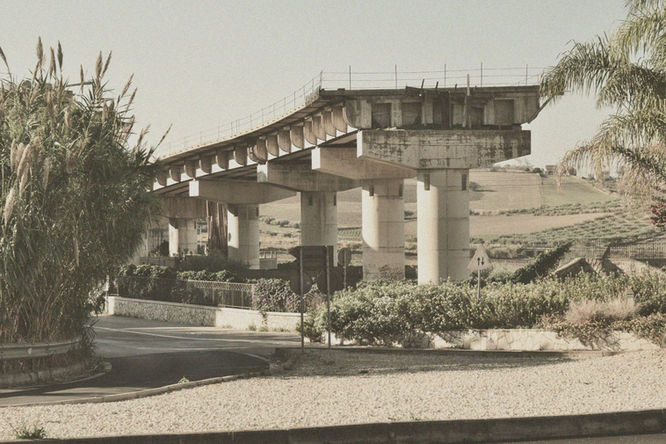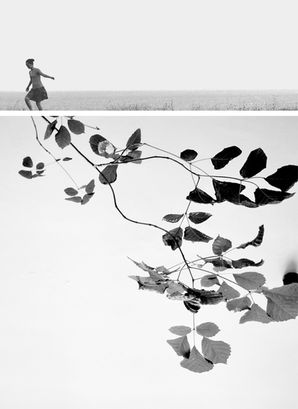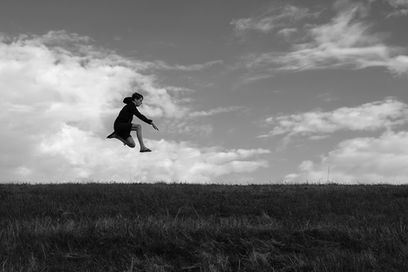
PERIPHERAL PLACES
June 15, 2025
INTERVIEW
PHOTOGRAPHY Catia Montagna
INTERVIEW Melanie Meggs
In ‘Peripheral Places’, Catia Montagna constructs a lyrical topography of the ephemeral — a series of triptychs that speak softly but resonate deeply. Born in Italy and now living between the United Kingdom and her homeland, Catia is an academic economist by profession, but her artistic voice is shaped not by data, but by a deep, intuitive sensitivity to the poetry of the everyday. A Progressive Street photographer with a growing international presence, her work reveals a philosophical and reflective perspective — one grounded in an awareness of time, memory, and social impermanence.
‘Peripheral Places’ is part of her long-term series ‘Short Stories’ — a project that distills fleeting encounters and spatial poetics into carefully curated triptychs. These “short stories,” as Catia terms them, are not narratives in the traditional sense. Instead, they are elliptical visual fragments, as minimal and open-ended as whispers of verse, anchored in the belief that less is often more. The triadic structure, like a literary vignette, provides just enough to provoke memory and emotion without closing the interpretive door.
The places Catia captures are non-places in the Augé sense, but they hum with subtle presence. The human figure is nearly absent, but never far. Traces remain: an empty chair, a bent signpost, an empty vehicle — all imbued with the quiet echo of lives once present. Catia’s skill lies in making these echoes visible. Her photographs are not didactic; they ask rather than answer. Who passed through here? What moment unfolded just before or after the shutter clicked?
There is an undeniable temporal dimension to her work. Time does not march forward. Each image is a still point in a turning world, evoking that moment when something is already becoming memory. This feeling is enhanced by her muted tones and soft natural light, which eschew the harshness of modernity for something quieter and more reflective. Her compositions feel accidental yet exacting, and always respectful of the space they depict. The photographs avoid central focal points, compelling us to explore the margins — mirroring Catia’s deeper thematic exploration of the periphery, both as a physical and conceptual space. The tension between the built and the grown is constant, neither fully dominant, each quietly coexisting in states of neglect and endurance.
The power of Catia’s work lies in its suggestion rather than its certainty. Each story gains resonance. Images echo and enrich one another through subtle repetition and variation. Sequenced together, the works invite a slow, inward movement — not forward, but deeper into perception. What do we ignore? What lies just beyond our field of view? What stories do the edges tell?
In this conversation, we explore the quiet architecture of her vision: her relationship to time, place, and disappearance, and how her dual background in economics and art shapes a photographic voice that speaks not in statements, but in questions.

“Looking back at photographs, I often wonder what became of those people with whom I briefly coexisted in a certain place and at a given moment in time. People who only left a trace of light through the lens of my camera, an impression in my memory. Who were they, where were they going?
These questions always evoke the idea of a story in my mind and raise the further question of how long a photographic narrative should be – so as not to provide the viewer with too narrow an interpretative key.
This is how I began to conceive a project consisting of a series of ‘short stories’ – each of three photographs – that, as in literature, are more ‘open-ended’ than longer, more articulate narratives. Tales that are as short as the chance encounters that underpin them, with human presences often barely hinted at, and united by the fact that the narrator in each is the ‘place’ in which they unfold: places that speak of the passing of time and the ephemerality of existence reflected in the imprints it leaves on objects and landscapes.
In Peripheral Places the stories unfold outside large urban centres in sometimes anonymous places, places of passage and of discrete existences frozen in instants of the present as they are already turning into the past.” - Catia Montagna
IN CONVERSATION WITH CATIA MONTAGNA
THE PICTORIAL LIST: Each story is structured as a photographic triptych. What did the 3-image structure offer you narratively or emotionally that a single image or longer series could not?
CATIA MONTAGNA: I think the triptych works well on both a narrative and emotional level for me.
The idea of developing short photographic stories did not come to me till the first story in this series – The King of Diamonds – was born. On our way to Brescia to see a Fontana’s exhibition, we stopped at a café near Cremona. It was a quiet and rather hot summer day, with a glaring light, and I was immediately taken by the almost out-of-time atmosphere of the place. I wanted to capture it and took a handful of photos.
As we got back on the road, without looking at the photographs, I started to visualise a triptych. It was all rather instinctive, really. I felt there was a story to be told and one single photo could not do it: there was the sign, the dusty courtyard, the somewhat dated décor of the café and inside, behind the old rope curtain, the young people chatting quietly in the rarefied silence of the heat. But to convey the uncertain aura of the place, I knew the story had to be barely sketched, as short as a Japanese haiku.
Looking back at it later, it reminded me of the first collection of short stories by Katherine Mansfield I ever read, as a teenager. I was thoroughly captivated by their narrating power – sketched, and yet precise, descriptions of places and people, stories that lingered in the mind and provoked strong emotional responses partly because of their very sense of unfinished.
That is how the idea of developing this concept came to me.
TPL: Your visual stories lean into ambiguity and openness. How do you negotiate the tension between revealing just enough and allowing space for mystery, interpretation, and the viewer’s own projection?
CATIA: I see photography as being intrinsically relational: it is in its nature to say and not to say, to suggest rather than reveal, leaving room for interpretation in what is, ultimately, an open dialogue, a conversation between the photographer, her subjects and the viewer. And as with any conversation, communication is the most effective if any one actor does not take over and dominate the exchange!
So, clearly, there is always a tension between the richness of a story and that ‘space for mystery’, as you call it, that has to offer room for the viewer’s freedom of interpretation – or the freedom of interpretation of the photographer, for that matter… A degree of ambiguity needs be there for me too; if a lot is left unsaid, I myself see something different every time I look back at a story.
I suppose that is how I resolve this tension – I put into a story just enough not to kill my own curiosity…
TPL: You refer to the narrator in these stories as ‘the place’ itself. How do you decide when a place is speaking – and what gives a place, in your eyes, narrative authority?
Yes, in these short stories I chose to put the ‘place’ at the centre, as narrator, and to barely hint at the human presence – which I find is increasingly the case when I do street photography. I suppose this partly reflects the strong sense I have of the importance of places, of how they shape and are shaped by our lives. Places speak and can reveal more of a society and a culture than the people who move in them do. I spoke earlier of the relational nature of photography. I very much agree with the view – so powerfully expressed by Ariella Azoulay in her Civil Imagination – that the subject-actors relationship in photography unfolds in and is influenced by the ‘public space’. And our interaction with the public space occurs at the intersection between our personal experiences and the social and cultural structure that precedes those experiences – which, incidentally, is another reason why these stories may speak differently to different people.
So, to go back to your question: how do I decide when a place is speaking – and what gives a place narrative authority? It is very subjective. The atmosphere of a place is the first trigger for me when taking photographs. And it is that atmosphere that gives it narrative authority. I need to ‘feel’ the place – and I find that for me this is all the more likely the most ‘normal’ is the place, be it in a city or in the countryside. When a place speaks to me, I want to give it voice through my photographs…whether others will hear the same story remains to be seen – but that is the beauty of it all, I think.
TPL: There is a powerful meditation on time and memory throughout this work. How does photography help you process the ephemerality of life – the sense of ‘things passing’ – both personally and conceptually?
CATIA: The unstoppable passing of time – I felt it since I was a child. This sense that we are ourselves very transient has gone hand in hand with a certain inability to live in the moment. Photography helps me in this. It is a powerful way for me to feel the moment; it accentuates my awareness of the here and now. I guess for me the experience of photography is what gets closer to a state of meditation. When I photograph, I become oblivious to everything else, and all that exists is that instant. Transient and insignificant as a moment might be, by pressing the shutter I freeze it and recognise its importance, not so much or not always with the intention of documenting it or constructing memories, but to experience it fully in the very instant it is already turning into the past.
In this sense, the personal and the conceptual are very much entwined, as it were.
TPL: What does the term ‘peripheral’ mean to you – geographically, emotionally, philosophically – and how does it manifest through the series?
CATIA: The ‘peripheral’ has always been quite central to my academic interests and work, not least because it is such a multifaceted and dynamic concept. As the non-centre, it can be seen as referring to what is marginal or less important, e.g. in the context of geographical, economic, or social hierarchies – what makes a ‘periphery’ and what does a periphery reveal about the ‘centre’? But the peripheral can also hold the unexplored or the unknown and invite exploration.
In a narrow sense, in this series of short stories, the periphery manifests itself in the locations of passage from which we can at best glimpse the busy life of the ‘centre’, or in the sense of quietness but also of remoteness and isolation of a place.
But there is more to the idea of periphery than this. To live in the world, to interact with it, to even begin to make sense of it, we need to be able to transcend our own skin and, from within our core, to cross our mental and emotional periphery. And photography can act as the key that unlocks our own boundaries and allows us to look beyond what we see...
When a place speaks to me, I want to give it voice through my photographs.

TPL: Do you find these peripheral places reflect aspects of your own identity, perhaps your experience of living and travelling between countries, cultures and disciplines?
CATIA: Yes, our photography, the lens through which we look at and interpret reality is always the product of who we are.
So, I guess my fascination with these peripheral places is somewhat shaped by my personal experiences. Growing up in a working-class environment meant experiencing to an extent both the geographical and the sociological meaning of periphery. And living abroad, travelling across borders has given me glimpses of what it means to inhabit the periphery of a culture.
TPL: Is there a relationship between stillness in place and stillness in thought that you are seeking through your photography?
CATIA: Yes, I think unconsciously this may well be the case. As I said, photography is also a means for me to fully live in the moment, and achieving a state of temporary stillness is instrumental to it.
TPL: Do you set out with a narrative intent when photographing, or does your story form in later reflection – almost like finding poems in prose?
CATIA: Normally, setting out with a narrative intent in photography does not work for me! I am rather instinctive – I respond to a situation, to a place, or to an atmosphere.
At times, the idea forms while I am taking a photograph and this prompts me to take more pictures, to try to tease out a story that can articulate what I feel. At other times the idea forms later when, looking back at photographs, I start to see patterns emerge that bring out new meanings and interpretations.
TPL: If so, how has your work on this project changed your relationship with photography?
CATIA: My relationship with photography changes all the time; the more I photograph, the more my photographic interests evolve and the more I feel the need to experiment.
This project has had a strong impact because it has changed my view of what a narrative can be. Interestingly, as I am developing the short stories, I have started to work on a couple of projects that are more documentary in nature and therefore require more articulate narratives. But even in these projects, I am very much aware of the tension between revealing and leaving space for the viewer’s interpretation.
TPL: What possibilities are you imagining for the next chapters of Short Stories?
CATIA: I see it continue to evolve as an exploration of the narrative power of photography, developing in several directions, both in terms of ‘places’ and ‘themes’. In this series of short stories, I used colour – something I do not often do – because when it all started, in the King of Diamond café, I was struck by the light and colour of the scene. I am now working on a black and white series. But the project is still very much fluid, and its final shape could well be very different from what I am currently imagining.

Catia Montagna’s ‘Short Stories’ are not just about the photographs — they’re about how she sees, how she listens to places most people might pass by. There’s something deeply resonant in her way of working, of letting the world speak softly and capturing those moments just before they vanish. It’s a generous kind of storytelling, one that doesn’t seek control but connection. In her hands, the peripheral becomes central, not just geographically but philosophically. She reminds us that photography can be a way of paying attention, of honoring what’s easily missed. And in doing so, she gives weight to the fleeting and finds meaning in the margins.







































